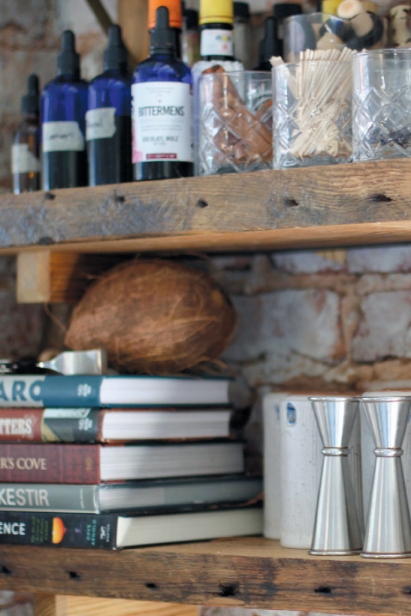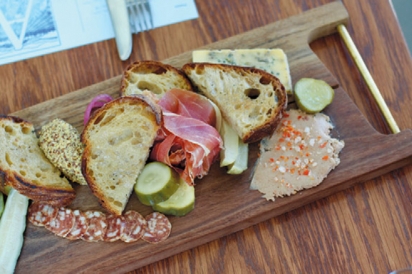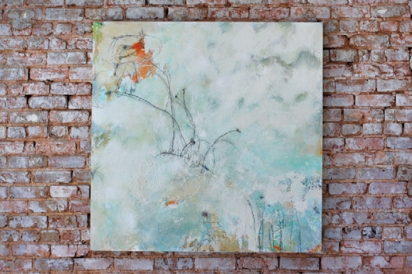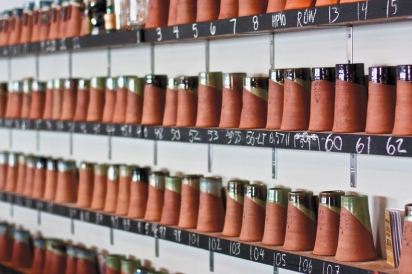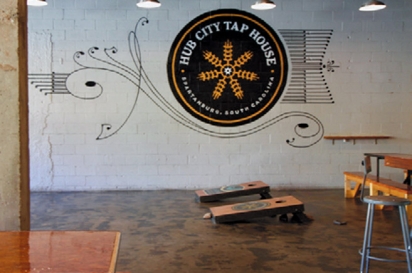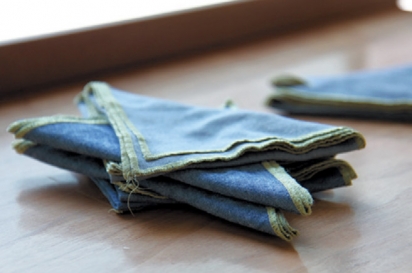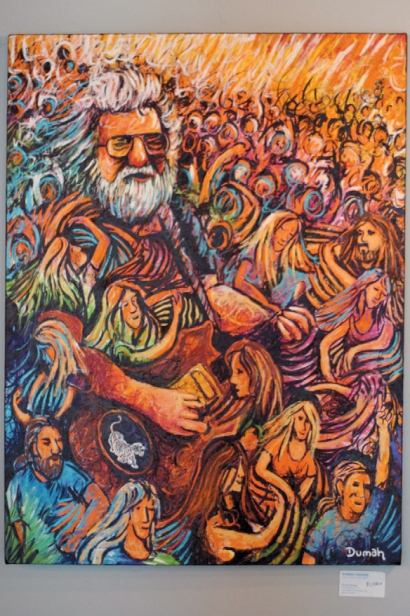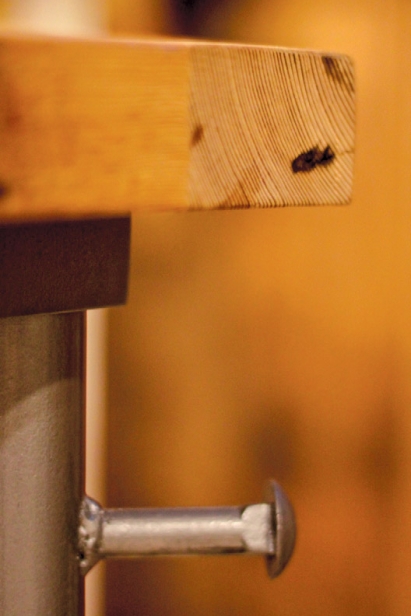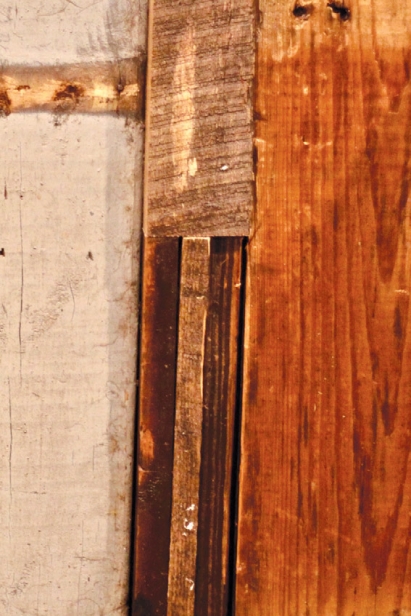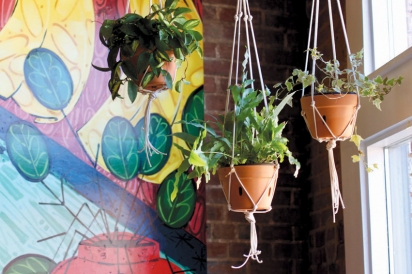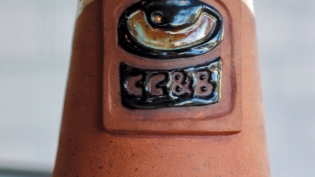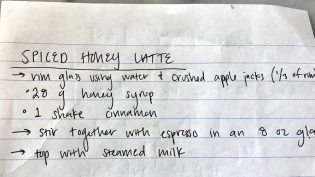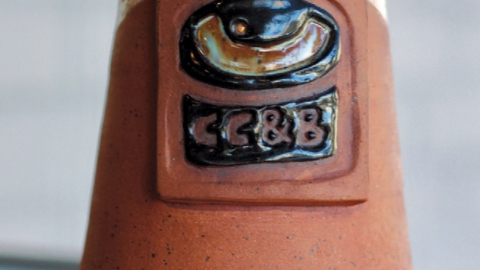Studio-to-Table
Upstate food and drink makers are teaming up with local artists to create meaningful spaces to eat, drink, and gather—and the implications for the community we love are significant.
CREATIVE COLLABORATIONS
Dining out recently, I audibly “oohed” when a plate piled high with hand-cut pasta was delivered to my table. But it wasn’t because of my pasta; it was because of the literal plate, which upon further inquiry I discovered had been custom-made by a local ceramicist. I was giddy—the artistic fusion that was happening between the plate and the food on top of it was invigorating. This is how it should be! I thought. And so my quest began. I wanted to find other Upstate restaurants partnering with artists in the region—as natural a pairing as steak and Cab, each better because of the other.
As I asked around town, I discovered not just plates but lighting, table tops (and table bottoms!), murals, even aprons—all locally made at the restaurant’s request. I expected to hear that the artwork was thoughtfully commissioned to “enhance the diner’s aesthetic experience.” Honestly, that would have been enough.
What I didn’t expect was how deep these partnerships run. The more local artists and chefs and restaurant owners I cornered, the more I realized they weren’t teaming up just for show. This isn’t about some chef using color theory to find bowls that make his beet soup “pop.” Sure, chefs and brewers and owners want to enrich their customers’ experience in their space, but they aren’t stopping there. A deeper community building is happening inside these collaborations. These beauty exchanges are full of benevolence and grace. What’s happening in places like the Village of West Greenville, where artists and chefs work together and beside one another to create authentic spaces that are both functional and beautiful, isn’t, as I’d originally thought, merely a “natural” pairing. It’s a subversive one.
Chefs are having their moment in the spotlight. To showcase their food and give it the reverence it supposedly deserves, some of the finest restaurants across the country have modeled their interiors after art museums: sparse white walls, personality-free servers in starched white aprons, uniform white plates. The goal? Make everything except the food disappear.
But some of the food influencers in Greenville are trying something different. Instead of presenting dishes (or even cups of coffee) as artwork to be admired and photographed (always photographed), they are creating warm and inviting spaces with personality. These are the ones who cook or make beer or curate wines because they love taking care of people, and their spaces feel more like homes than art museums.
THE ANCHORAGE: A GATHERING PLACE
Take, for example, Chef Greg McPhee at The Anchorage. Even as his star rises (thanks to recent mentions in Bon Appetit and Garden and Gun, among others), he maintains his clear vision. Along with his wife Beth, Chef McPhee conceived of The Anchorage as a “gathering place, a neighborhood spot.” The caveat: it’s impossible to make a place feel familiar that isn’t. For this to work, Chef McPhee knew he would have to engage his surroundings in an authentic way. Once he had a spot in the Village of West Greenville, he looked around—literally. And 80 yards away there was a ceramicist, so Chef McPhee hired him to make plates… more than 300 of them.
The benefits to ceramicist Darin R. Gehrke include income but, maybe more importantly, exposure. As part of their training, each of the servers at The Anchorage can direct inquiring guests toward the origin of all the art pieces, whether that’s their plate or the light hanging above their table or the art on the wall behind them.
Chef McPhee benefits from complete customization, requesting a particular size plate (that fit the particular size custom table, all of which fit their particular spot in a particular neighborhood). He also commissioned bowls and mugs and, with Beth, chose glazes from samples Darin made.
But even if you never knew the plates were custom, you couldn’t walk into The Anchorage without noticing some imaginative detail. Kendra Schrimmer, a server at the restaurant but also a local flower farmer at Laurel Creek Florals, created the moss artwork that hangs on the interior walls. These aren’t just pretty; they are Chef McPhee’s creative approach to soundproofing. And the list of artistic partnerships goes on and on.
The stunning mural on the side of the building, a vibrant garden scene hand-painted by Sunny Mullarkey McGowan and Liz Kenny, has become the geographical marker for most things in The Village. Scandinavian brass light fixtures are the creations of Lonely Mountain Metal-works with light cords by Snakehead Vintage. The antique church pew you’ll sit on while you inevitably wait for a table (this place is that good) was sourced by Whim and refinished by local treasure Barb Blair. Both the wooden tables and the gorgeous charcuterie boards were custom-made by Slab Woodworks. The art displayed on the walls was curated by Teresa Roche at Art and Light Gallery, just down the road from the restaurant and home to a dozen Greenville-area artists.
Maybe reliance on the locals seems like the kind of thing someone does early in his career, progressing from homegrown to slick and chic after hitting it big time. But Chef McPhee isn’t going to “move on.” The community collaborations are central to his vision, from aesthetic appeal to menu inspiration to accountability for the quality and well-being of the neighborhood. He even credits some of the restaurant’s success to these partnerships. “I don’t think we can build a better arts or food culture without collaboration,” he says. “What’s pushing us forward is that we’re willing to work with each other. And not just willing but excited to do it.” Members of the Village of West Greenville Business Association and personal patrons of these artists, the McPhees are the epitome of beauty cultivators who labor for the greater good.
CICLOPS CYDERI AND BREWERY: THE ART OF DRINKING
Another excellent model is Ciclops Cyderi & Brewery in Spartanburg, located inside the beloved Hub City Tap House. Proximity was influential here, too: a couple years back ceramicist Allison Gross, owner of Oak Leaf Pottery, heard the buzz about a new bar opening in town. Her first thought was, “How cool would it be to have a place like this using my mugs?” So she made a prototype and, despite her fierce introversion, forced herself to walk through the front door soon after their opening.
Luckily, the person on the other side of that door was co-owner Kolby Garrison, one of the most gregarious, inviting humans you’ll ever meet. Willing to gamble on Allison, he ordered a batch of 25 mugs on the spot using the last dollars he had in the bank that day. Once introduced to customers, the mugs sold out in four hours.
At Ciclops the mugs aren’t just an accent. As the inspiration for their mug wall and “Hub Club,” they have helped shape the culture of the place. Patrons who buy a mug can drink from it every time they come in, and true regulars who drink 99 different varieties of beer are upgraded to the “Board of Directors,” where they sip from top-shelf mugs bearing the Ciclops logo. Shelves along the back wall display the mugs, now numbering more than 150.
Allison has had other opportunities to work with local restaurants, including Rainer’s Café downtown. It was the confidence she gained from the Rainer’s partnership that gave her the idea to approach Ciclops. “I can’t thank these owners enough for taking a chance on me,” Allison says.
Other recognizable pieces of the brewery were crafted by locals. The steel front of the bar was designed by Kevil Belue, known to locals as “The Man of Steel.” He also made the steel bases for the community tables. Artwork in the shape of South Carolina hangs on one wall, made by local contractor Ben Palmer and using wood over 200 years old.
But even before you notice Allison’s mugs or Kevin’s bar, you’ll probably spot the giant mural on the wall of the bar and brewery. Painted by Russell Bannan and Eli Blasko, the public artist team Bannon Blasko, the mural bears the original name of the bar before the owners started brewing their own beer in 2015. Despite rebranding “we’ll always keep it,” Kolby says, “because it’s a part of the place.”
Not only does Ciclops make beer locally, they are integrated into the Spartanburg community in a hundred different ways. Located directly across the street from the Chapman Cultural Center downtown, Ciclops has even partnered with the Spartanburg Philharmonic Orchestra to create custom beer pairings that reflect the spirit of concerts there. (For a Mendelssohn-heavy performance, they brewed a German blend named for the town where the composer lived his final years.) No one needs convincing that this symbiosis is a beautiful thing: I think we can all agree the only thing that improves a concert is a beer made for that concert, and the only thing that improves a beer is a concert made for that beer. Here again, from patron to artist to brewer, everyone is a winner.
METHODICAL COFFEE: CUSTOM CAFÉ
This collaboration was one of my favorites, probably because it was so unexpected. A painter painting is one thing, but what might a maker and designer of artisan clothing have to offer a restaurant? Evidently kindness is the mother of creativity. Bill Mitchell, a local maker of custom jeans, wanted to support his buddies Will Shurtz and Marco Suarez as they opened a storefront in the center of downtown to house their coffee enterprise. He envisioned barista aprons that weren’t just functional but beautiful, too, with precise engineering of straps, pockets, and colors to suit the coffee slinger.
The result is the coolest looking baristas in town, their aprons every bit as fashionable as Billiam Jeans’ original product. The aprons worn by Methodical employees were cut from dark dyed denim and can be worn as a full or half apron. They’re reversible, too.
Since then Billiam Jeans has created aprons for Nose Dive, The Standard, and many other coffee shops nationwide. Bill’s own thoughtfulness first benefited Methodical Coffee, but call it karma: it led to a whole branch of his business he couldn’t have foreseen. Bill admires the venues willing to pay a little extra to have the best of the best. “It speaks to the restaurants’ choices,” he says, “which are high-level right down to their food.” It’s yet another example of how artist, owner, and customer benefit when highquality, local items are prioritized.
I hear Methodical’s coffee tastes amazing, but I must confess: I don’t drink coffee. Not a drop. So it has to mean something that nonetheless I’ve sat in their café, drinkless, on multiple occasions. The beauty of that place cannot be denied. (Even the baristas are beautiful to watch, I swear it.) The packaging is so pretty I’m tempted to nail a bag of coffee to my wall. No surprise—it was designed by artist Annie Koelle (see Artists Who Cook). Another of my favorite collaborations? The cloth napkin squares were custom-made by the owners’ moms. Wooden tables and the bar were also designed by Slab Woodworking. All of these details add up to a gorgeous space where even java abstainers have much to drink in.
THE COMMUNITY TAP: PULL UP A SEAT
From the beginning, The Community Tap has been a neighborhood joint. Back in 2010 the growler approach encouraged patrons to return again and again for fill-ups, getting to know their beer guy whether they wanted to or not. The place has since evolved into more of a gathering place, evidenced by its relocation, expansion, and the addition of tables and seating. The Community Tap is our Cheers, a place people go habitually to socialize, escape, or work with a pint in hand.
Owners Ed Buffington and Mike Okupinski aren’t trying to blaze a hipster trail by commissioning art from their region. No, this is as authentic as it gets: one gets the impression they never even considered there might be another way to go about outfitting their space. If a local artist wasn’t going to do it, who would?
Inside The Community Tap are handmade tabletops by woodworker Jacob Holley constructed with bases by metalworker John Geck. These two makers had never collaborated until their project at The Community Tap. Jacob walked through the door one day with ideas for wooden tables, and John entered the very next day with photos of his metalwork using bike cogs. The owners of The Community Tap had the idea of introducing them and seeing what they could come up with together. The result is custom tables with the warm, wooden look they wanted combined with unique bases made with their many cycling customers in mind.
Post-expansion, the owners wanted to include a private room that was rental-ready for events. They hired Chelsea Rosen and Matt McLain of TreeHugger Customs to add interest to the walls, resulting in the distressed wooden panels. The art on the walls, including the painting of the owners themselves in a crowd of beer lovers, was created by Dumah (Paul Morgan).
The Community Tap is another example of a space that is not only a seamless reflection of the neighborhood but also a major impetus for community growth. Their presence has attracted retailers and traffic, transforming what used to be a sad little strip of the North Main area into a major shopping and gathering hotspot in less than a decade. The owners’ welcoming approach to local makers is a significant part of the ongoing renewal of this section of town.
STUDIO-TO-TABLE
When you think about the kind of place you want to live, what is more appealing than stories of local artists wandering into spaces and offering their services—to the delight of shop owners? What is better than chefs who train their servers to know where various art studios are located so they can point patrons right to them, handing over the address along with the credit?
These collaborations are the natural evolution of the farm-to-table movement, in which chefs have increasingly paired with farmers for both sourcing and menu development. When farm-to-table is done right, both the chef and the farmer benefit equally, the labor of each one contributing to the welfare of the other. Perhaps we call this next step “studio-to-table,” wherein the work of local artists enriches the work of food makers and influencers. And the ultimate beneficiary is the patron, as the quality of the product and the experience is inevitably increased.
I am first and foremost an artist (yes, even before I’m an eater), and maybe it was just my own passion for the local art and maker movement that inspired this piece. I didn’t expect a moral of the story. And yet here it is: Art is not a zero-sum game. Creativity begets creativity, and in Greenville we all flourish when artists invest in the success of other artists.
As recognition for our region lights up our social media feeds (another top ten list!), folks around here are increasingly concerning themselves with the future of this place. What will all the new restaurants, apartment buildings, and parking lots mean for us? The Upstate is growing, but how will we grow, and what kind of place will we become?
Partnerships like the ones on these pages are models for how the rest of the Upstate might work together to make a place that’s better for all of us, growing well together. We don’t have to be chefs or artists to find ways to appreciate, patronize, and assist our neighbors. We don’t have to be chefs or artists to share our own little spotlights. Maybe that’s just the thing to keep an authentic, local feel to the place we all love.
Artists About Town
THE STANDARD
Aprons by Billiam
CAVIAR AND BANANAS
Art by Annie Koelle
BARISTA ALLEY
Art by Alyssa Martin
BIRDS FLY SOUTH
Beer labels by Chris Koelle and Alexander Harrison
Art by Bathsheba Floyd and Gina Giacomantonio
Farmhouse tables and tap board by Treehugger Customs
NOSE DIVE
Aprons by Billiam
THE VILLAGE GRIND
Painting by Glory Day Loflin
Mugs by Will Donovan and Darin Gerkhe
Goods for sale by JoBee Designs (Jo Johnson)
GB&D
Art by Mark Mulfinger
FARMHOUSE TACOS
Art by Joe Hiltabidel
Art by Honeyhush (Kelly Rabon)
Bar top by DM2 Furnishings (David Marshall and Sam Bixby)
RAINERS CAFÉ
Plates, mugs, bowls, and dressing cups by Oak Leaf Pottery (Allison Gross)
UPCOUNTRY PROVISIONS
Art by rotating resident artists (every 6 months)
Retail from Modern Forestry Candles, Creative Living Wellness Serums



